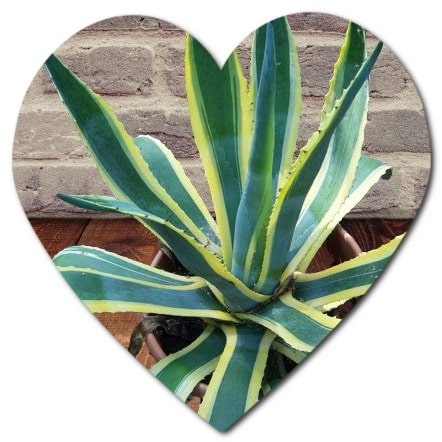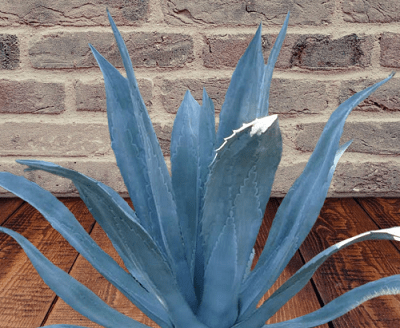Agave americana, commonly known as the century plant or American agave, is characterized by its distinctive morphological features, which contribute to its unique appearance and adaptability to arid environments. Here are the key morphological characteristics of Agave americana:
- Rosette Form: Agave americana typically forms a large, symmetrical rosette of leaves. The rosette can be quite extensive, with individual plants often reaching several feet in width.
- Leaves: The leaves are succulent, fleshy, and lance-shaped. They are often described as sword-like. The leaves can grow quite large, ranging from 3 to 6 feet (0.9 to 1.8 meters) in length and 4 to 8 inches (10 to 20 centimeters) in width. They are typically a blue-green to gray-green color.
- Leaf Margins: The edges of the leaves are lined with sharp, spiny teeth or terminal spines. These spines serve as a defensive mechanism to deter herbivores from consuming the plant.
- Apical Spine: At the very tip of each leaf is a formidable, large, and sharp apical spine, which is the most prominent of all the leaf spines. This spine can be dangerous and should be handled with care to avoid injury.
- Leaf Arrangement: The leaves are densely packed in a rosette formation, with new leaves emerging from the center of the rosette and older leaves radiating outward.
- Flowering: Agave americana is monocarpic, which means it flowers and produces seeds only once in its lifetime, after which the main rosette dies. The flowering stalk is an impressive and tall structure, often reaching heights of 20 to 40 feet (6 to 12 meters). The flower spike is covered in numerous small, yellow or greenish-yellow flowers.
- Root System: Agave americana typically has a shallow root system that spreads widely. This helps the plant capture rainwater efficiently in its arid habitat.
- Habitat Adaptation: These morphological characteristics, such as fleshy leaves and a compact rosette form, are adaptations to arid and semi-arid environments. The succulent leaves store water, while the rosette shape minimizes water loss and maximizes water collection.
- Cultural Significance: In its native regions of Mexico, Agave americana has cultural and economic importance. The fibers extracted from its leaves are used for traditional textile production, and the sap, known as aguamiel, can be fermented to make pulque, a traditional Mexican alcoholic beverage.

Agave americana’s distinct morphology, including its large rosette of fleshy, spiny leaves, is one of its defining features, making it a standout succulent in arid and desert landscapes.
How do I identify agave Americana?
Identifying Agave americana, commonly known as the century plant or American agave, can be relatively straightforward due to its distinctive characteristics. Here’s how to identify Agave americana:
- Rosette Form: Agave americana typically forms a large, symmetrical rosette of leaves. This rosette can reach several feet in width, and it may have a dense or open structure, depending on the age of the plant.
- Leaves: Look for long, fleshy, and lance-shaped leaves that radiate outward from the center of the rosette. The leaves are often bluish-green to grayish-green in color. They can be quite large, measuring 3 to 6 feet (0.9 to 1.8 meters) in length and 4 to 8 inches (10 to 20 centimeters) in width.
- Leaf Margins: Examine the edges of the leaves, which are lined with sharp, spiny teeth or terminal spines. These spines are often arranged in a sawtooth-like pattern.
- Apical Spine: At the very tip of each leaf, you’ll find a prominent and sharp apical spine. This spine is usually larger and more formidable than the other leaf spines.
- Leaf Arrangement: Agave americana’s leaves are densely packed within the rosette, with new leaves emerging from the center and older leaves extending outward. The arrangement of the leaves forms a symmetrical and striking rosette shape.
- Flowering: Keep an eye out for a tall and impressive flowering stalk that emerges from the center of the rosette. This flowering spike can reach heights of 20 to 40 feet (6 to 12 meters) and is covered with numerous small, yellow or greenish-yellow flowers. The flowering stage is a key feature, but it only occurs once in the plant’s lifetime.
- Habitat: Agave americana is commonly found in arid and semi-arid regions, such as desert landscapes, rocky slopes, and well-drained soil. Its adaptation to dry environments is reflected in its succulent leaves.
- Leaf Spines: The presence of sharp spines, particularly the apical spine at the leaf tip and the teeth along the leaf margins, is a distinctive feature of Agave americana.
- Size: Take note of the plant’s overall size. Mature Agave americana plants can be quite large, with rosettes that reach several feet in width and tall flowering spikes.
- Location: Agave americana is commonly found in regions with a Mediterranean climate, desert climate, or similar arid conditions. It may be growing in gardens, xeriscapes, and other urban or natural environments in these areas.
Agave americana’s unique and striking appearance, along with its adaptation to arid environments, makes it relatively easy to identify when you encounter it in its native or cultivated habitats. The presence of a tall flowering spike and the characteristic leaf spines are key identifiers of this plant.
What are the characteristics of agave Americana?
Agave americana, commonly known as the century plant or American agave, has several distinctive characteristics that set it apart from other plants. Here are the key characteristics of Agave americana:
Rosette Form: Agave americana typically forms a large, symmetrical rosette of leaves. The rosette can reach several feet in width, and it may have a dense or open structure, depending on the age of the plant.

Leaves: The leaves of Agave americana are fleshy, succulent, and lance-shaped. They are often bluish-green to grayish-green in color and have a waxy coating that helps reduce water loss. The leaves can be quite large, measuring 3 to 6 feet (0.9 to 1.8 meters) in length and 4 to 8 inches (10 to 20 centimeters) in width.
Leaf Margins: The edges of the leaves are lined with sharp, spiny teeth or terminal spines. These spines serve as a defensive mechanism to deter herbivores from consuming the plant.
Apical Spine: At the very tip of each leaf is a prominent and sharp apical spine. This spine is usually larger and more formidable than the other leaf spines.
Leaf Arrangement: Agave americana’s leaves are densely packed within the rosette, with new leaves emerging from the center and older leaves extending outward. The arrangement of the leaves forms a symmetrical and striking rosette shape.
Flowering: Agave americana is monocarpic, which means it flowers and produces seeds only once in its lifetime, after which the main rosette dies. The flowering stalk is a tall and impressive structure, often reaching heights of 20 to 40 feet (6 to 12 meters). The flower spike is covered with numerous small, yellow or greenish-yellow flowers. The flowering stage is a key feature but only occurs once in the plant’s lifetime.
Habitat: Agave americana is commonly found in arid and semi-arid regions, such as desert landscapes, rocky slopes, and well-drained soil. It is well-adapted to dry environments, thanks to its succulent leaves.
Leaf Spines: The presence of sharp spines, particularly the apical spine at the leaf tip and the teeth along the leaf margins, is a distinctive feature of Agave americana.
Size: Mature Agave americana plants can be quite large, with rosettes that reach several feet in width and tall flowering spikes.
Cultural Significance: In its native regions of Mexico, Agave americana has cultural and economic importance. The fibers extracted from its leaves are used for traditional textile production, and the sap, known as aguamiel, can be fermented to make pulque, a traditional Mexican alcoholic beverage.
Agave americana’s striking appearance, size, and adaptation to arid environments make it a noteworthy and iconic succulent plant. Its presence in arid and desert landscapes is often a testament to its resilience and unique characteristics.
